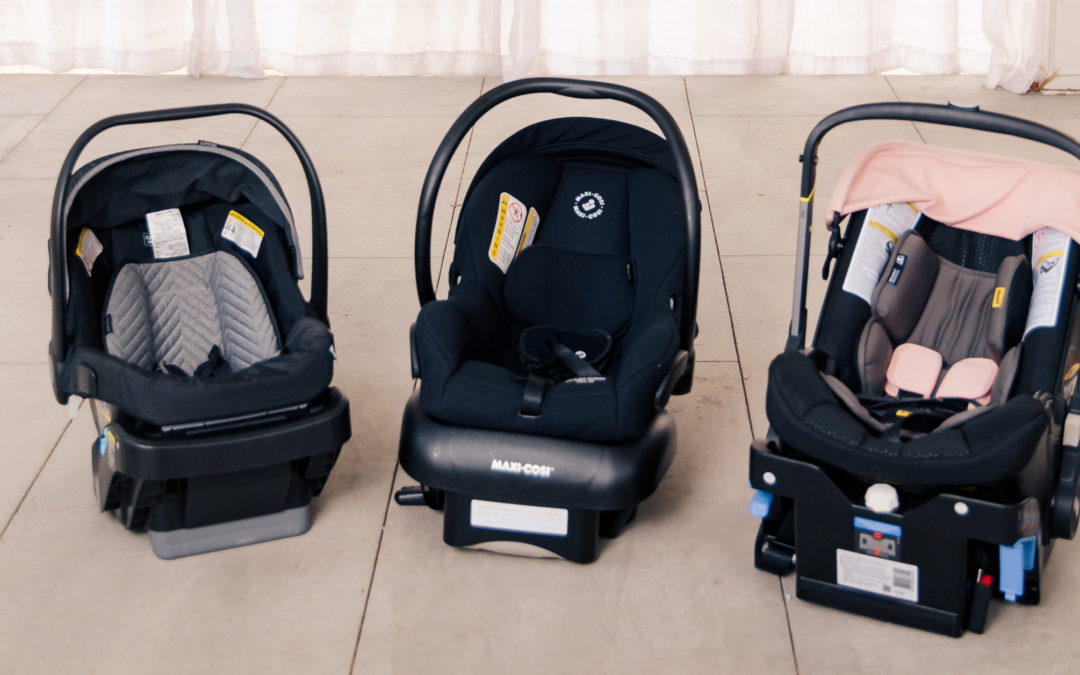One of the hardest things about parenting an infant is watching how fast they grow. In one blink they’re just discovering their hands, and in another blink they’re toddling around saying their first words.
As they reach each milestone, some of the gear you relied on in the early days gets stowed away for the next baby. Bye goes the bassinet, then the swing, followed by the bottles and pacifiers—and somewhere in there it’s time to put the infant car seat away.
Car seats are one of your most expensive and important pieces of baby gear. And, often, parents hope to reuse them for as many babies as possible! But in order to maintain the integrity of the car seat year after year, you must be intentional about your long-term storage solutions. As you’re graduating to a convertible car seat, check out this guide to safely storing your infant car seat:
How to Store an Infant Car Seat
Check for wear and tear.
Before you tuck away your car seat, look for signs of wear and tear. With proper use, normally a car seat will have little to no wear and tear after the first child. Minor cosmetic issues, such as pilling or stains in the fabric, usually aren’t a problem. However, if you see frayed or torn straps, cracks in the base, or any issues with the buckle mechanisms, don’t bother storing it. If you really want to keep it, try calling the manufacturer for advice or replacement parts.
Clean your car seat.
To avoid mold and rodents looking for a midnight snack of forgotten Goldfish and fruit snacks, clean your car seat before you put it away.
Refer to the manual for specific washing instructions, but at the very least, we recommend that you vacuum out all debris and wipe down the car seat with a washcloth and warm water. We love the eufy handheld vacuum.
If the car seat includes machine washable padding, that’s great! But don’t machine wash or even submerge the harness straps, as it may reduce their overall durability. Instead, just use a towel and, if allowed, an additive-free cleanser — like plain dish soap.
Once your car seat is vacuumed and washed, ensure that it’s completely dry. Storing a wet or damp car seat could lead to toxic mold growth. We recommend drying your clean car seat by setting it in the sun since UV rays are also a natural disinfectant. For more detailed instructions on how to clean and dry your car seat, refer to this article.
Store car seat parts and accessories together.
There’s nothing worse than pulling out something that’s been stowed away, only to find its missing parts. Whether it’s your blender, a jigsaw puzzle, or your expensive infant car seat, it’s frustrating and wasteful.
So, before you put the main seat away, make sure you’ve collected all the parts, including infant inserts, strap padding, additional bases, and/or the visor. Pro tip: if you have specific stroller adaptors for your car seat, keep those alongside the car seat too! Store your unused car seats with every piece. It will be one less thing to worry about when the new baby comes!
Use the right containment system.
As we said, car seats are expensive and important, so they should be handled with care. To ensure that there’s no damage from the elements, keep the car seat covered and contained. No dripping ceiling, curious pets, or falling objects can touch your car seat with the right containers. We’ll get more into what that looks like below!
Find a place with no moisture.
Car seats are HUGE. That usually means we store them in spacious areas of our home, like our garage, attic, or basement. Or, we opt to keep them in a separate storage unit. The only problem is these areas can be damp, dirty, and home to all sorts of critters. (Even if your home is clean and your basement is finished, you may still run into these issues!)
To safely stow away a car seat, find a storage space with no moisture problems. The back of a closet or the corner of a room works great, but if that’s too intrusive, choose one of the obvious spots. Just make sure you resolve the moisture issue or take precautions before you store it. We have some anti-moisture and anti-pest solutions below!
Check on your car seat every few months.
Even if you feel like you have the perfect containment system, pull the car seat out and check every few months. If you notice something is damp or there are mouse droppings near the box, you can take action fast before your items are ruined. However, if you follow these steps, you hopefully won’t experience any problems!
Can You Reuse Infant Car Seats?
Car seat safety is top of mind at Safe in the Seat 100% of the time. We are sure it’s the same for you! So, the question is: “Is it safe to reuse your infant car seat?” The answer is: “Yes!” Or, rather, “probably.” There are a few things to determine before you make the choice to reuse.
First of all, what condition is the car seat in? When you were going through the earlier steps in this post, did you find any wear and tear? If you did, it’s probably time to get rid of the car seat.
Next, check the car seat expiration date. YES, car seats do expire. More about that here. But, the fact is: you absolutely should not use a car seat past its expiration date. Most car seats last 7-10 years from the manufacture date. If you already bought a used car seat, that date may be closer than you think!
If you don’t think you’ll have another child before the seat expires, or in the case that there is damage to the car seat, it might be time to recycle your car seat. Target hosts a twice-annual event where you can trade in your old car seat for a 20% off coupon.
They recycle the seat for you, and you can buy a new car seat for the upcoming baby with a discount! (Plus, if you have a Red Card, you get an additional 5% off.) It’s a great deal and for a great cause. Do your part to keep unsafe seats off the streets!
Where to Store Car Seats in House
You can store your car seat anywhere in your house that’s free from excess moisture and exposure to the elements. Additionally, keep your car seat away from areas of your home or property where rodents and other pests sneak in.
Here are the best places:
- The back of a closet.
- The corner of a room that is not often used.
- A climate-controlled storage unit.
- A finished or partially finished attic.
Here are secondary places you could use with some precautions:
- A finished basement.
- A garage with good protection from the elements.
What You Need to Store Your Car Seat
Storage Bag
You know those big bags people use to check car seats at airports? (Not you. You know you should always bring your car seat on board with you.) Though those bags don’t do much to protect your car seat from the plights of air travel, they work great as a protective bag for long-term storage!
For the first layer of protection, store car seats in one of these bags. There are a range of options that I recommend including, Slynnar Car Seat Bag, Yorepek Padded Car Seat Bag, and J. L. Childress Deluxe Wheeled Car Seat Bag. Use any of these car seat travel bags as your first level of protection for long-term car seat storage.
Box or Tub
Next, you need a box or large tub to put the bag into. I know, this might be pretty huge! The original box your car seat came in works great. Otherwise, you can use a plastic tote like this. The dual layers of protection – the travel bag and the box – will prevent most car seat storage disasters!
Moisture Wicking Solution
Moisture is a big concern when storing anything for a long time. You can pack your item away in mint condition, only to find that moisture got inside and the whole thing is teeming with mold. It’s the worst feeling! To prevent accumulation of moisture (especially in damp places) use a reusable moisture pouch, a moisture-absorbing tub, or a dehumidifier.
Plastic Zipper Bags
To keep your manual, inserts, and any other extra parts safe, toss them in a large zippered plastic bag and stow them inside the travel bag. Now, everything will be ready when you want to take the seat back out again. And, not even the manual will have a water spot or tear!
Peppermint Rodent Repellent Bags
For a kid-safe way to repel pets, use these natural pest control pouches. Put them around the box or in the layer between the bag and the box. We don’t recommend placing these directly on your car seat anywhere.
Even though they’re natural, it’s best to keep them out of reach of children and inside that box. However, if a creature happens to get inside, the sharp minty scent will send them scurrying away from your expensive equipment.
Storing your infant car seat the right way will ensure your baby gear is ready for the next newborn!
If you’re ready to store your car seat, do it the right way. Tossing that thing in the garage or leaving it in the damp basement is not a good choice! Get a good return on your investment by getting multiple uses out of your baby gear.
For more car seat tips and tricks, browse our blog and head over to Instagram and YouTube! And, if you haven’t chosen your next car seat yet, we can help. Check out our car seat buying kits that’ll help you find the best car seat for you and your little one! We’re here to help keep every kid safe in their seat.
Affiliate links are included above. Safe in the Seat earns a small commission when you purchase through these links with no cost to you. We so appreciate your support.

